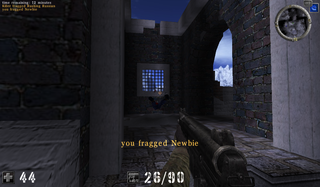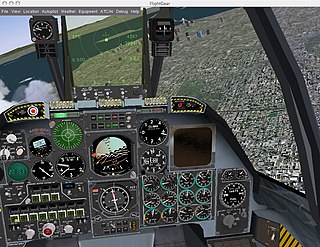
Quake II is a 1997 first-person shooter video game developed by id Software and published by Activision. It is the second installment of the Quake series, following Quake.

Quake is a first-person shooter game developed by id Software and published by GT Interactive. The first game in the Quake series, it was originally released for MS-DOS, Microsoft Windows, and Linux in 1996, followed by Mac OS and Sega Saturn in 1997 and Nintendo 64 in 1998.

Rise of the Triad: Dark War is a first-person shooter video game, developed and published by Apogee Software in 1995. The player can choose to play as one of five different characters, each bearing unique attributes such as speed and endurance. The game's story follows these five characters who have been sent to investigate a deadly cult, and soon become aware of a deadly plot to destroy a nearby city. A remake was designed by Interceptor Entertainment and released by Apogee Games in 2013. The shareware version of the game is titled Rise of the Triad: The HUNT Begins.
Shareware is a type of proprietary software that is initially shared by the owner for trial use at little or no cost. Often the software has limited functionality or incomplete documentation until the user sends payment to the software developer. Shareware is often offered as a download from a website. Shareware differs from freeware, which is fully-featured software distributed at no cost to the user but without source code being made available; and free and open-source software, in which the source code is freely available for anyone to inspect and alter.
In computing, cross-platform software is computer software that is designed to work in several computing platforms. Some cross-platform software requires a separate build for each platform, but some can be directly run on any platform without special preparation, being written in an interpreted language or compiled to portable bytecode for which the interpreters or run-time packages are common or standard components of all supported platforms.

Deathmatch, also known as free-for-all, is a gameplay mode integrated into many shooter games, including first-person shooter (FPS), and real-time strategy (RTS) video games, where the goal is to kill the other players' characters as many times as possible. The deathmatch may end on a frag limit or a time limit, and the winner is the player that accumulated the greatest number of frags.
Urban Terror is a freeware multiplayer first-person shooter video game developed by FrozenSand. Originally a total conversion of id Software's Quake III Arena, FrozenSand released Urban Terror as a free standalone game in 2007 utilizing ioquake3 as the game engine. While the game engine is licensed under the open-source GPL, Urban Terror's game code is closed source and its assets are freeware but not open content.
Game programming, a subset of game development, is the software development of video games. Game programming requires substantial skill in software engineering and computer programming in a given language, as well as specialization in one or more of the following areas: simulation, computer graphics, artificial intelligence, physics, audio programming, and input. For multiplayer games, knowledge of network programming is required. In some genres, e.g. fighting games, advanced network programming is often demanded, as the netcode and its properties are considered by players and critics to be some of the most important metrics of the game's quality. For massively multiplayer online games (MMOGs), even further knowledge of database programming and advanced networking programming are required. Though often engaged in by professional game programmers, there is a thriving scene of independent developers who lack a relationship with a publishing company.

An open-source video game, or simply an open-source game, is a video game whose source code is open-source. They are often freely distributable and sometimes cross-platform compatible.

AssaultCube, formerly ActionCube, is an open source first-person shooter video game, based on Cube and uses the same engine, the Cube Engine. Although the main focus of AssaultCube is multiplayer online gaming, a single-player mode consists of computer-controlled bots.
Linux-based operating systems can be used for playing video games. Because few games natively support the Linux kernel, various software has been made to run Windows games, software, and programs, such as Wine, Cedega, DXVK, and Proton, and managers such as Lutris and PlayOnLinux. The Linux gaming community has a presence on the internet with users who attempt to run games that are not officially supported on Linux.

C-Dogs, the sequel to Cyberdogs, is a shoot 'em up video game where players work cooperatively during missions, and against each other in "dogfight" deathmatch mode.

Ryan C. Gordon is a computer programmer and former Loki Software employee responsible for icculus.org, which hosts many Loki Software projects as well as others. Gordon's site hosts projects with the code from such commercial games as Duke Nukem 3D, Shadow Warrior, Quake III Arena and other free and open source projects for multiple platforms.

The Official Hamster Republic Role Playing Game Construction Engine is a free and open-source, "all-in-one" game creation system. It was designed to allow the quick creation of 2D role-playing video games (RPGs). It was originally written by James Paige in QuickBASIC and released in late 1997 or early 1998. In May 2005, the source code was released as free software under the GNU GPL-2.0-or-later, and it was soon ported from QuickBASIC to FreeBASIC and to modern operating systems.

indiePub Entertainment, Inc. was a publisher of video games based in Cincinnati, Ohio, United States.

Blobby Volley is a free and open-source sports computer game series in which two blobbed shaped entities play volleyball against each other. There are multiplayer and single-player modes.











